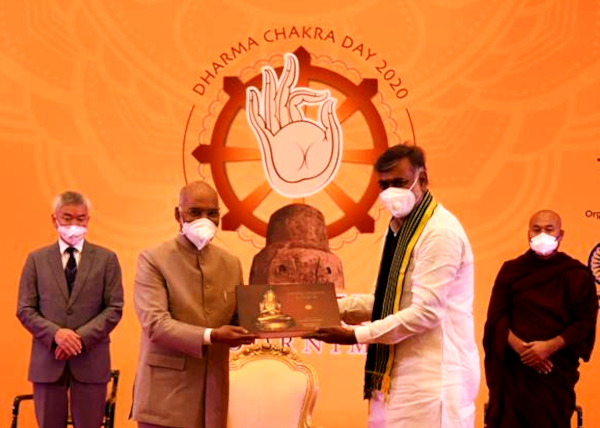The Ministry of Culture has taken up the project of reprinting of 108 volumes of Mongolian Kanjur under the National Mission for Manuscripts (NMM). The first set of five volumes of Mongolian Kanjur published under the NMM was presented to the President of India Shri Ram Nath Kovind on the occasion of Guru Purnima, also known as Dharma Chakra Day, on 4th July 2020. A set was then handed over to His Excellency Mr. Gonching Ganbold, Ambassador of Mongolia to India by the Minister of State (Independent Charge) of Ministry of Culture and Minister of State (Independent Charge) of Ministry of Tourism, Shri Prahlad Singh Patel in presence of Minister of State for Minority Affairs, Shri Kiren Rijiju.
It is expected that all the 108 volumes of the Mongolian Kanjur will be published by March, 2022.
The Pime Minister of India, Sh. Narendra Modi in his address on the occasion of Dhamma Chakra expressed:
“On this day of Guru Poornima, we pay homage to the Lord Buddha. On this occasion, the copies of the Mongolian Kanjur are being presented to the Government of Mongolia. The Mongolian Kanjur is widely respected in Mongolia.”
The National Mission for Manuscripts was launched in February 2003 by the Government of India, under the Ministry of Tourism and Culture, with the mandate of documenting, conserving and disseminating the knowledge preserved in the manuscripts. One of the objectives of the mission is to publish rare and unpublished manuscripts so that the knowledge enshrined in them is spread to researchers, scholars and general public at large. Under this scheme, reprinting of 108 volumes of Mongolian Kanjur has been taken up by the Mission. It is expected that all the volumes will be published by March, 2022. This work is being carried out under the supervision of eminent Scholar Prof. Lokesh Chandra.
Mongolian Kanjur, the Buddhist canonical text in 108 volumes is considered to be the most important religious text in Mongolia. In the Mongolian language ‘Kanjur’ means ‘Concise Orders’- the words of Lord Buddha in particular. It is held in high esteem by the Mongolian Buddhists and they worship the Kanjur at temples and recite the lines of Kanjur in daily life as a sacred ritual. The Kanjur are kept almost in every monastery in Mongolia.Mongolian Kanjur has been translated from Tibetan. The language of the Kanjur is Classical Mongolian.The Mongolian Kanjur is a source of providing a cultural identity to Mongolia.
During the socialist period, xylographs were consignd to flames and monasteries were bereft of their sacred scriptures.During 1956-58, Professor Raghu Vira obtained a microfilm copy of the rare Kanjur manuscripts and brought them to India. And, the Mongolian Kanjur in 108 volumes was published in India in 1970s by Prof. Lokesh Chandra, former Member of Parliament (Rajya Sabha).Now, the present edition is being published by the National Mission for Manuscripts, Ministry of Culture, Government of India; in which every volume will have a list of contents indicating the original title of the sutra in Mongolian.
Historical interaction between India and Mongolia goes backcenturies. Buddhism was carried to Mongolia by Indian cultural and religiousambassadors during the early Christian era. As a result, today, Buddhists form the single largest religious denomination in Mongolia. India established formal diplomatic relations with Mongolia in 1955.Since then, the overwhelming relationship between both the countries has now reached a new height. Now, the publication of Mongolian Kanjur by the Government of India for the Government of Mongolia will act as a symbol of cultural symphony between India and Mongolia and will contribute to furtherance of bilateral relations during the coming years.
Source: PIB
Image Courtesy: PIB
You may also like
-
India Can’t Afford to Remain Stagnant at this Juncture, Says PM Modi; Asks People to Buy Locally-Made Goods
-
Stolen Artefacts to be Returned to India from Scotland Museums
-
Netaji’s Hologram Statue at India Gate
-
10th Century Stone Idol of Goat Head Yogini IllegallyRemoved from A Temple in Lokhari, Banda, UP Being Returned to India
-
UNESCO Inscribes ‘Durga Puja in Kolkata’ on the Representative List of Intangible Cultural Heritage of Humanity
